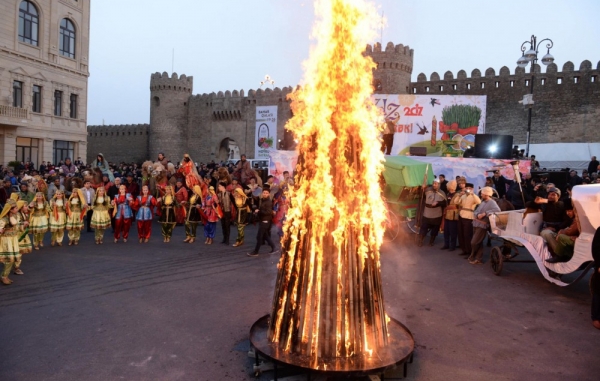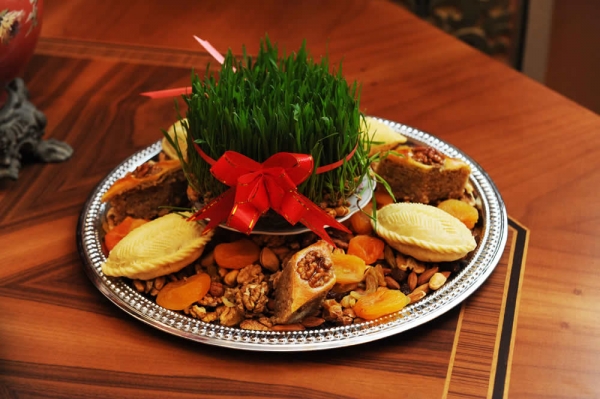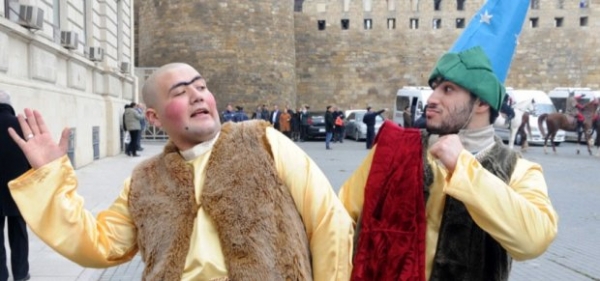[naewoeilbo내외일보] Lee Su Han이수한 기자 = Novruz holiday is one of the most important and favorite holidays of the Azerbaijani people. It marks the arrival of spring and is celebrated on the vernal equinox, March 20-21 – the beginning of the astronomical New Year. The festivities last for several days and the preparations for them start early at the end of the last month of winter. Novruz is the time at which people say goodbye to the old year and prepare for the sense of physical and spiritual renewal that the spring brings.

The origin of Novruz dates back to ancient customs and rituals associated with sorcery, cult of nature and fertility, as well as beliefs in nature’s decline and rise. During the month leading up to Novruz, every Tuesday is devoted to celebrating nature’s four elements consecutively: water, fire, air (or wind) and earth, the last one, called “Akhir Charshanba”, representing the time when the leaves bud out and the spring finally begins.
Samani is a symbol of Novruz and it is grown from sprouted seeds in advance to have it ready on the table by the night of celebration. Along with samani, painted eggs, and baked holiday sweets set a festive mood.
One of the essential parts of the holiday table is Khoncha (xonça) – a tray filled with sweets, nuts, candles, and other treats. Each of the sweets baked for Novruz has a symbolic meaning. Baklava represents the four parts of the world, Gogal – the sun, Shekerbura – the moon, and the eggs painted for Novruz are a symbol of life. Samani decorates the middle of the tray and is tied with red ribbon. Traditionally, the table has to include seven items all starting with the letter “S”: sabzi (greens), sumac (seasoning), sud (milk), sirka (vinegar), samani and others. But the main meal of the Novruz table is pilaf. Neighbors and friends send trays filled with treats to each other.

The day before the holiday people meet to congratulate each other. On festive tables candles are lit and wishes made. The number of candles corresponds with the number of family members. In the evening, children put hats under neighbors’ doors and hide, waiting for the neighbors to fill the hats with holiday favors. After the sunset people gather in the streets to kindle bonfires, dance around them, and jump over them to cleanse their souls and ward off evil spirits. On the second day of Novruz, people visit the graves of the relatives and friends to honor their memory.
Novruz is also the time for mass gatherings and festivals. Ashiq and folk music concerts are held countrywide on this day. Ropewalkers demonstrate their skills, pehlevans (wrestlers) compete against each other, comedy performances with the participation of two characters, Kos-Kosa (goat beard) and Kechal (the bald), are held on the streets. Kos-Kosa represents the winter, Kechal – the spring. In the verbal competition Kechal always comes out a winner.

In the rural areas, interesting horse races, called chovqan, are being organized. But the main festivities usually take place by the walls of the legendary Maiden Tower. The top of the tower is decorated with a huge Samani, and the beauty Bahar (spring) lights the torch installed on the tower the flame of which symbolizes the awakening of nature and life.
Interestingly, the above mentioned attributes of Novruz holiday seem very similar to Jeongwol Daeboreum holiday in Korea, which in turn can be an interesting research topic for studying possible historical and cultural similarities between Azerbaijani and Korean peoples.
At the fourth session of the Intergovernmental Committee for the Safeguarding of the Intangible Cultural Heritage in 2009, multinational nomination “Novruz, Nowruz, Nooruz, Navruz, Nauroz, Nevruz” of Azerbaijan, India, Iran, Kyrgyzstan, Pakistan, Turkey and Uzbekistan was inscribed on the Representative List of the Intangible Cultural Heritage of Humanity.
At the eleventh session of the Intergovernmental Committee for the Safeguarding of the Intangible Cultural Heritage in 2016, Afghanistan, Iraq, Kazakhstan, Tajikistan and Turkmenistan joined the nomination.